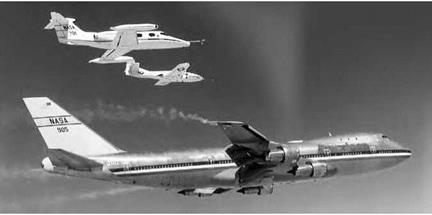Wake Vortex Research
The 1970s inauguration of widebody jumbo jets posed special problems for smaller aircraft because of the powerful streaming wake vortices generated by aircraft such as the Boeing 747, Douglas DC-10, and Lockheed L-1011. After several unexplained accidents caused by aircraft
upset, and urged by organizations such as the Flight Safety Foundation and the Aircraft Owners and Pilots Association, the Federal Aviation Administration (FAA) asked NASA and the U. S. Air Force to initiate a flight-test program to evaluate the effect of the wingtip vortex wake generated by large jet transport airplanes on a variety of smaller airplanes. The program began in December 1969 and, though initially ended in April 1970, was subsequently expanded and continued over the next decade. Operations were performed at Edwards Air Force Base, CA, under the supervision of the NASA Flight Research Center in cooperation with the Ames Research Center and the U. S. Air Force, using a range of research aircraft including 747, 727, and L-1011 airliners, and smaller test subjects such as the T-37 trainer and QF-86 drones, supported by extensive wind tunnel and water channel research.[848]
|
The Boeing 747 subsequently modified as carrier aircraft for the Space Shuttle Orbiter furnished NASA the opportunity to undertake vortex upset using the Lear Jet and Cessna T-37 trainer shown here flying formation on the larger aircraft. NASA. |
Subsequently, in 1972, NASA intensified its wake vortex research to seek reducing vortex formation via aerodynamic modification and addition of wind devices. By the beginning of 1974, Alfred Gessow, the Chief of Fluid and Flight Dynamics at NASA Headquarters, announced the Agency was optimistic that wake vortex could be eliminated "as a constraint to airport operations by new aerodynamic designs or by retrofit modifications to large transport aircraft.”[849] Overall, the tests, and ones that followed, had clearly demonstrated the power of wake vortices to constrain the operations GA aircraft; light jet trainers and business aircraft such as the Lear Jet were buffeted and rolled, and researchers found that the vortices maintained significant strength up to 10 miles behind a widebody. As a result of NASA’s studies, the FAA introduced a requirement for wake turbulence awareness training for all pilots, increased separation distances between aircraft, and mandated verbal warnings to pilots during the landing approach at control-towered airports when appropriate. NASA has continued its wake turbulence studies since that time, adding further to the understanding of this fascinating, if potentially dangerous, phenomenon.[850]











